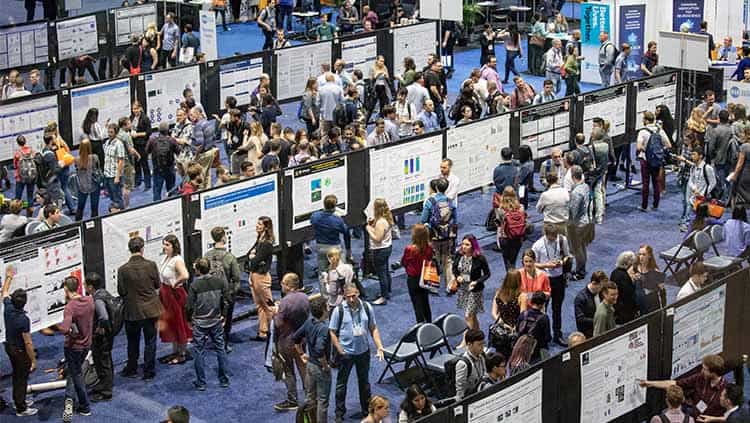Reaching out – with eyes closed – to find and touch a small, ringing bell is a simple, but accurate method of checking a patient’s overall awareness of surrounding space and synchronization of eyes and ears.
That’s the finding of Mind-Eye Institute scientists who presented the first Institutional Review Board (IRB)-approved empirical evidence of the effectiveness of the Z-Bell Test℠ at the Society for Neuroscience conference in Chicago in October 2019. The Mind-Eye Institute (https://mindeye.com) is based in Northbrook, Ill.
The Z-Bell Test℠ enables health professionals to evaluate a patient’s retinal processing, said study investigator, Deborah Zelinsky, O.D. Dr. Zelinsky is founder and executive research director of the Mind-Eye Institute and inventor of the Z-Bell Test℠.
“Retinal processing” refers to the brain’s ability (partially beneath a conscious level of awareness) to filter sensory signals, sending the filtered version for further brain processing. The brain processing combines the retinal signals with other sensory signals (from hearing, smell, taste and touch), synthesizes the information and reacts and responds, depending on many internal sensory signals.
When intact, retinal processing enables people to have internal systems (such as balance and posture) running automatically. This “cruise control” allows a person to respond appropriately to the external world around them. If brain circuitry is out of sync because it has been disrupted – or, in the case, of younger children, perhaps under-developed — people can become confused about their surrounding environment and exhibit inappropriate reactions and responses, Dr. Zelinsky said.
In a randomized, double-blind study, Dr. Zelinsky and co-investigator, Clark Elliott, PhD, an expert in artificial intelligence, applied the Z-Bell Test℠ to nearly 40 student volunteers from DePaul University Chicago and conducted painstaking, follow-up analysis of some 120,000 video frames. Specifically, the scientists measured distances between outstretched fingertip and bell and found that students touched or were significantly closer to the bell — with eyes closed – when wearing prescribed lenses to help them locate sound in space than when wearing just clear lenses or lenses designed “to create dissonance and impair sound location.”
During a typical Z-Bell evaluation, a patient has their eyes closed and tries to locate and touch a ringing bell. If the patient cannot do so, a Mind-Eye optometrist places different lenses, prisms and filters across the patient’s closed eyelids until an optimal combination allows the patient to find the bell immediately. These optical appliances bend the ways in which light disperses across the retina, thereby impacting brain function.
“Even when eyes are closed, a low level of light still passes through the eyelids and stimulates the retina, which is composed of brain tissue and is an overlooked part of the central nervous system,” Dr. Zelinsky says. “Retinal stimulation also activates parts of the brain not used for eyesight. With eyes closed, patients are still having to visualize surrounding space in order to locate the bell.”
“By placing various types of lenses across a patient’s closed eyes, we can change the way light spreads over the retina, thus modifying the dynamic relationship between the mind’s visual inputs and the body’s internal responses,” she explains.
Dr. Zelinsky is internationally known for her work involving the retina’s impact on brain function. For the past 30 years, she has devoted her career to neuro-optometric rehabilitation and development of advanced methods for assessing brain function, with emphasis on the often-untested linkage between eye and ears. Her patented research in novel uses of retinal stimulation has been described in publications and courses worldwide.
“Retinal signals are transmitted to much more than the brain’s visual cortex for eyesight. Some signals are channeled to the hypothalamus and the brainstem, as well as smaller locations within the brain. With the Z-Bell℠ Test, optometrists at the Mind-Eye Institute are able to prescribe eyeglasses that help synchronize a patient’s auditory and visual spatial perception,” Dr. Zelinsky says
Most current eye testing emphasizes the clarity of central eyesight, which is used only for non-moving targets – like an eye chart or a book, Dr. Zelinsky told the audience in presenting Z-Bell study data. “What goes untested are a patient’s peripheral eyesight, for ‘seeing’ moving targets in surrounding space, and eye-ear integration, which is important for developing successful academic and social skills.
“Moving targets are found in many places in the environment, including on screens used in GPS navigation systems or web site scrolling. We use peripheral and central eyesight as a team to scan and shift gaze from place to place, such as from a dashboard to the road when driving, or from a desk to a teacher, or from a tennis ball to a player,” she said. “We typically use peripheral processing to guide where our attention is placed.
“Our Z-Bell study represents an important step toward revolutionizing standard methods of eye care. Eye testing is shifting from 20/20 eye acuity to ‘brain testing.’ The 20/20 system of eye examination needs an update; it’s over 150 years old,” Dr. Zelinsky concluded. “20/20 should be left in the 20th century as we become 21st century practitioners.”

Media
Society for Neuroscience 2019 Conference: Z-Bell Effective for Evaluating Eye-Ear Integration, Spatial Awareness
SEEING is ‘BELL’IEVING; STUDY ‘RINGS’ TRUE
